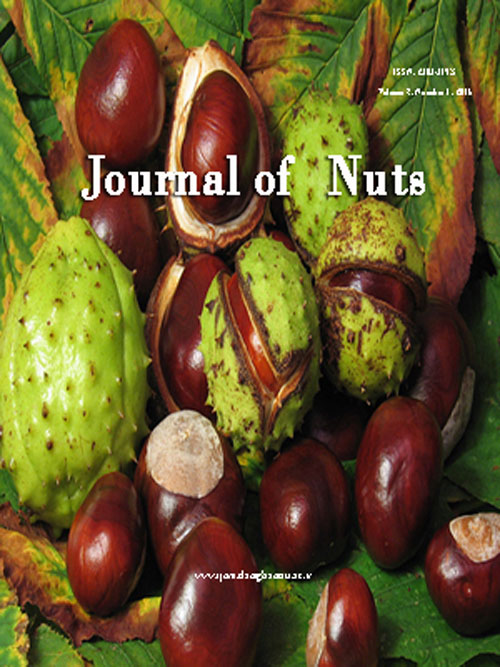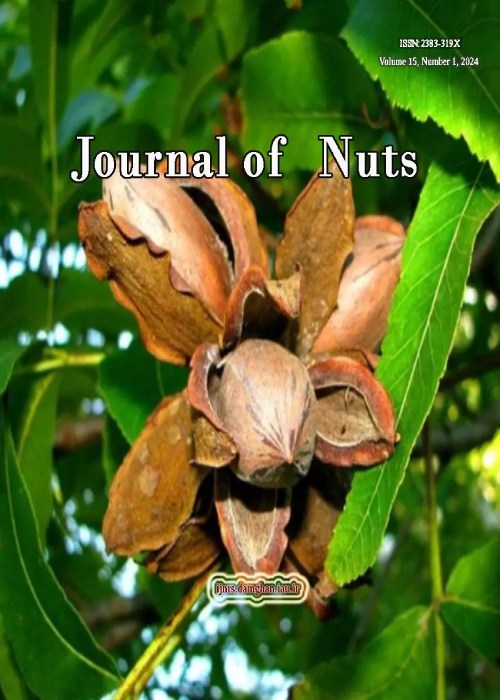فهرست مطالب

Journal of Nuts
Volume:9 Issue: 1, Winter-Spring 2018
- تاریخ انتشار: 1397/03/30
- تعداد عناوین: 8
-
-
Pages 1-10Drying is one of the most important stages of hazelnut processing and its optimization improves the quality of the final product. The quality of hazelnut is dependent on chemical and organoleptic characteristics of fruit that is affected in the drying process. In present research, samples of Gerd cultivar of hazelnut (Corylus avellana) were dried in shelled and in-shell forms using a laboratory dryer in single-layered form, in three temperatures of 40, 50 and 60°C and 1 m/s air velocity, and stored for six months. The time and energy required for drying and qualitative changes of hazelnut (oil content, protein content, acidity content and peroxide value of oil) were evaluated. The results showed that the hazelnuts dried under 60°C required the lowest time and energy for drying and the in-shell hazelnuts dried under this temperature (60°C) had the lowest acidity compared to other treatments. In addition, temperature had a significant effect on the qualitative traits of hazelnut. The results from taste tests showed that consumers prefer the shelled and in-shell hazelnuts dried in 50°C compared to other samples. Based on the results, the 50°C is recommended temperature for drying hazelnuts.Keywords: Acidity Content, Cultivar, Peroxide value, Protein content
-
Pages 11-20Walnut (Juglans regia L.) is a tree with significant economic value and usage for human health and various food industries. However, fresh walnut kernels are a less widespread product than the dried kernels. This study aimed to determine the fresh walnut kernel properties including, fatty acid composition, proximate composition, total phenolics (TPs), total antioxidant capacity (TAC), acidic, peroxide and saponification values of extracted oil and minerals of fresh walnuts kernels. Green walnut fruits were harvested on commercial maturity. The content of different fatty acids (%) was determined as 16:0; 5.91, 18:1; 77.7, 18.2; 11.13 and 18:3; 2.84. Also, the essential nutritional compounds such as protein content (16 ± 0.67), ash (3± 0.32), water (20 ± 0.49), fat (40 ± 0.22) and total carbohydrate (21 ± 0.23) were quantified and reported in percentages. The energy content was 508 ± 0.48 kcal. Acidic values, peroxide values and saponification values in walnut oil were 3 ± 0.14, 0.3 ± 0.06 and 130 ± 0.54 respectively. Furthermore, the average mineral contents were also determined. In general, it can be claimed that fresh walnuts have significant amounts of protein, oil and minerals, and higher water content in comparison with dry nuts. Nonetheless, our results in comparison with the information available about dry walnuts showed that fresh walnuts contained less oil content compared to dried fruits.Keywords: Antioxidant, Fatty acids, Juglans regia, Peroxide value
-
Pages 21-30Root and crown rot (gummosis) is known as the most destructive disease affecting pistachio in Iran. The efficiency of bacterial strains to reduce the growth rate of Phytophthora pistaciae was studied under different electrical conductivities (EC, 0, 2, 4, 8, 12 ds/m). Soil and rhizosphere samples were collected from pistachio growing regions in Kerman province, Iran, during 2011 - 2012. Overall, the strains of bacteria were presented in all sampling areas in both infected and uninfected orchards. Out of 400 bacterial isolates, 63% and 37% were collected from soil and rhizosphere samples, respectively. Among 400 bacterial isolates, 19 exhibited the highest ability to reduce the growth of P. pistaciae in dual culture, volatile and non-volatile compounds, though by different degrees. The degrees of inhibitory activities against mycelial growth of P. pistaciae by Pseudomonas fluorescens strains ranged from 40 to 97.5%, 8 to 97.5% and 7.5 to 90% in dual culture, non-volatile and volatile assays, respectively. The Bacillus subtilis strains reduced the growth of P. pistaciae by 22-92.5%, 17-85%, 21-92.5% in dual culture, non-volatile and volatile assays, respectively. The negative effects of ECs on the growth of P. pistaciae in modified CMA were observed in 8 and 12 ECs. ECs had no effect until 8 ds/m on the growth of P. pistaciae, while the mycelial growth decreased by ECs higher than 8 ds/m. No mycelial growth was observed at EC 14 ds/m. There were significant differences between different bacterial isolates, ECs and their interactions on the mycelial growth of P. pistaciae. The highest mycelial suppression belonged to isolates Nos. 123 and 112 in dual culture, volatile and non-volatile compounds test. More research is required to understand the native mechanisms involved in biological control under natural conditions in pistachio orchardsKeywords: Biological control, Electrical conductivities, Phytophthora, Rhizosphere, salinity, Sustainable agriculture
-
Pages 31-47Pistachio is one of the most important horticultural crops in Iran. There is a unique role for amino acids in the plant response to stressful conditions, and special physiological role for Arginine (Arg) compared to other amino acids. The effects of this compound were investigated on vegetative and reproductive characters of bearing pistachio trees of Ahmad-Aghaei. The experiments were done as a factorial based on RCBD with four concentrations of Arg (0, 100, 200 and 300 µM) and three spraying stages (post harvest, flower buds swollen and flowering). Based on the results, Arg improved the vegetative and reproductive characters. Arg increased length and diameter of shoot, leaf area, the number of floweringbuds, the number of nuts in cluster, fresh weight of cluster, nut splitting (%) and ounce, and decreased flower buds abscission percent and blankness. Arg also significantly increased photosynthetic pigments (chlorophyll a and b and total chlorophyll) in bearing pistachio trees. The best concentration of Arg was 200 µM applied of the flowering stage, but the strongest effect on the number of nut in cluster, fresh weight of cluster and blankness were observed when spraying at the flower bud swollen stage.Keywords: Arginine, Photosynthetic pigments, Pistachio, Vegetative growth, Yield
-
Pages 49-49Samples were collected from different regions of two provinces, Markazi and Semnan, their contamination by Aspergillus flavus was examined. The results of A. flavus colony counts in different samples of almond showed that among 20 experimented samples, 11 samples were contaminated by fungus; therefore, 8 cultivars of almond, Shahroud 6, Shahroud 21, Shahroud 12, Shahroud 8, Shahroud 17, Rabie, Mengha, and Sangi Shireen, were collected in order to evaluate their sensitivity to fungal colonization and the sporulation rate of fungus on them. The results of statistical analysis showed that on the third, fifth, and seventh days, Shahroud 12 was the least resistant cultivar [average pollution (99.5%)], whereas Shahroud 6 was the most resistant [average contamination (7.36%)] at a level of 5 % for growth of A. flavus after 7 days. Experiments related to the testa of almond show that the testa can be a barrier against penetration of fungus into the inner part of the almond, decreaseing fungal growth, and thus reducing the weight of mycelium and sporulation in almonds.Keywords: Almond, Aspergillus flavus, Cultivars, resistance
-
Pages 57-65The Persian walnut (Juglans regia L.) is one of the most valuable resources in Iran because of its multi benefits. The present study was conducted in Meshkin-Shahr in Ardabil province to investigate the important quantitative and qualitative characteristics of 31 walnut genotypes. Classification of genotypes was analyzed using the cluster method. The results showed that among selected walnut genotypes, SS genotype had the highest kernel weight (7.03 g), and fruits weight (12.65 g), and RM3 had the best kernel percentage 63.73%. The walnut genotypes were clustered into three groups using UPGMA cluster method. This preliminary study demonstrated that quantitative and qualitative characteristics were effective in evaluating the genetic diversity of walnut genotypes.Keywords: Cluster analysis, Genetic diversity, Kernel, Nuts, Walnut genotypes
-
Pages 67-76The study of poverty and income in equality are the most important subjects of social/ economic research in agriculture sector. The present study focuses on poverty and income inequality among pistachio growers in Kerman province. Absolute poverty line, relative poverty line, poverty gap and intensity were calculated. Also income distribution was investigated using Ginny coefficient, Lorenz curve and income distribution index. The statistical community was all pistachio producers in Kerman province. Data collected through personally interviewing of 200 producer, using multi-stage cluster random sampling, during 2012-2015 cropping years. The results showed that absolute poverty line for pistachio growers in Kerman province was 24000000 (10 Rials) while, relative poverty line was 64922675(10 Rials), annually. Results also indicated that 30 percent of farmers were suffering from absolute poverty while, 57 percent from relative poverty. Income gap for poor pistachio growers under absolute poverty was 0.48, but for poor pistachio growers under relative poverty was 0.60. According to Lorenz curve, Ginny coefficient of 0.66 and income distribution index, it can be concluded that there is an un-fair income distribution among pistachio growers in study area. Finally supporting capital availability specially for small scale poor farmers through low interest credit, production subsidies and national development funds is suggested.Keywords: Absolute poverty, Relative poverty, Income distribution, Poverty gap, Poverty intensity, Poverty line
-
Pages 77-83A greenhouse experiment was conducted to evaluate the freezing damage in some pistachio rootstocks by ion leakage and pH changes of leaked solution. A factorial experiment was carried out in randomized block designs (RBD) with three factors: Temperature (A) including 4 ̊C, 0 ̊C, -2 ̊C, -4 ̊C, -6 ̊C, Time (B) including 3, 12, 24h , and Rootstock (C) including P. vera cv 'Badami Zarand' (V13) and 'Sarakh's (S5), P. mutica (M1)and P. atlantica (A7). For this, one-year-old seedlings were kept at these five temperatures in incubator for 2 hours. Then in the first 24 hours in three hour intervals and during four days, EC and pH in leaked solution were measured daily. After four days the seedling samples were autoclaved at temperatures 105°C for 4 minutes to destroy all cell membrane. EC and pH of remaining solution were measured again and the percentage of ionic leakage was calculated. The results showed that the best time to evaluate the pH and ionic leakage was 24 hours after incubation of samples. Based on the results, ionic leakage dramatically increased with decreasing temperatures from 0°C to -6°C, while pH of leaked solution had no significant difference in 0°C and 4°C temperature treatments. When temperature reduced from 0°C to -6°C, like ionic leakage, pH greatly reduced. So the pH of the leaked solution could be an appropriate tool to study the freezing damage of pistachio rootstocks. Based on the results of pH and ionic leakage, P. mutica and P. atlantica were the most frost tolerant and sensitive rootstocks of this experiment, respectively.Keywords: Freezing tolerance, Ionic leakage, pH, Pistachio rootstocks


